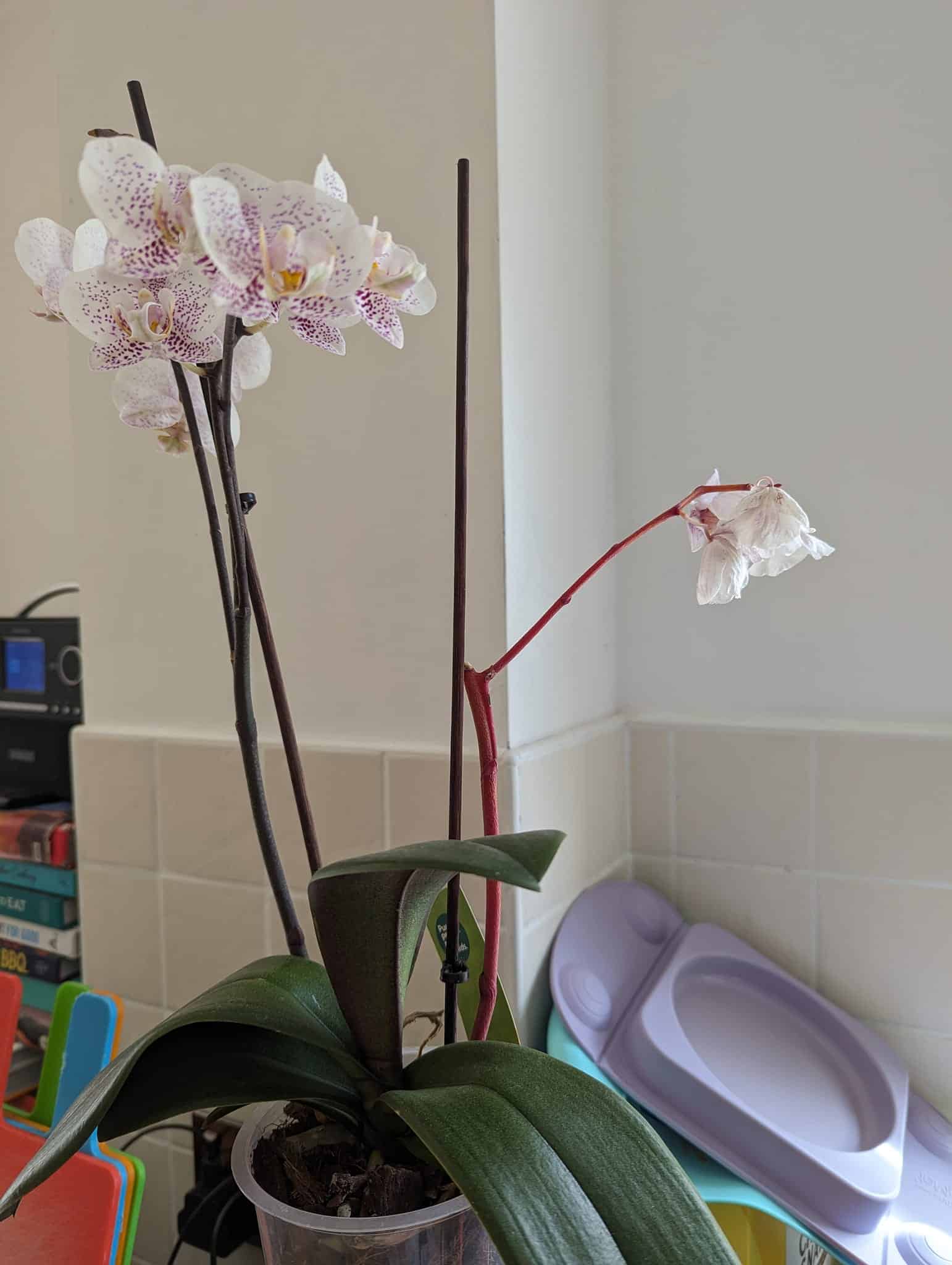Orchid produces appealing blossoms but are equally sensitive to minor disturbances causing several problems, including its stem turning red.
However, some Orchid varieties like Cattleya, Vanda, Dendrobium, etc., bear naturally red stem characteristics.
So, go through this complete article to know why your Orchid stems turn red with proper treatment measures.
Table of Contents Show
Reasons Behind Orchid Stems Turning Red
The stem of your Orchid may turn red due to transplant shock stress, but you need not worry, as it will heal after some time.
1. Improper Watering And Drainage
Improper watering may be the major reason behind orchid red stems, as the plant can’t withstand soggy and too-dry conditions.
Orchids prefer weekly watering during winter, but you need to water them twice a week during the hot days in summer.

Overwatering may cause soggy soil causing stem discoloration leading to mushy stems, wilting, and even death in plants.
Moreover, underwatering may stress your Orchid causing red stems with the dropping of leaves and flowers.
Improper drainage may create poor air circulation inviting many pathogenic diseases and root problems.
Thus, a pot with enough drainage holes and well-draining soil is best for the proper growth of Orchids.
Treatments and Preventive Measures
- Water your Orchid only when the top 2 inches of the soil feels dry.
- Only use distilled or filtered water for your Orchids, and avoid tap water.
- Use a moisture meter to prevent overwatering your Orchids.
- The bottom watering method will be beneficial for extremely underwatered Orchids.
- Watering with ice cubes will let your Orchid during slowly without any problems.
2. Sunlight Issues
Improper sunlight is a common problem in the reddening of Orchid stems, as Orchids are very sensitive to light.
Basically, Orchids prefer 5-6 hours of bright, indirect light to develop into healthy plants with good blossoms.
Thus, your Orchis is developing red stems due to direct sun exposure for too long or insufficient light.
Treatment and Preventive Measures
- Move your Orchid into the east-facing window for good morning light.
- Use sheer curtains to provide indirect light condition.
- Outdoors, select a shady place before placing your Orchids.
- Use artificial lights if the natural light is insufficient for Orchids.
3. Incorrect Temperature
Proper temperature is vital for Orchids as this delicate plant can’t withstand too high or freezing temperatures.
Your Orchid will grow best at its optimal temperature of 65-85°F but can tolerate as low as 50°F and as high as 80°F.
Thus, if your Orchid develops reddish or pinkish stems, it’s probably due to temperature issues.
Treatments and Preventive Measures
- Mist your Orchids once a day during the hot summer.
- Mulching around the base will help in maintaining proper temperature.
- Avoid placing your Orchid near a heater, cold drafts, and air conditioners.
- Provide frost blankets to protect this plant from the chilling cold.
- Use a thermometer to monitor the room temperature perfectly.
4. Nutrient Deficiency
Orchids aren’t heavy feeders regarding nutritional requirements, but low nutrition can be the reason behind their red stems.
For healthy development, feeding your Orchid with a balanced fertilizer with an NPK value of 10-10-10 is necessary.
Mainly, the lack of phosphorous in the stems leads to the accumulation of anthocyanin pigments in Orchid stems.
Treatment and Preventive Measures
- Only use balanced Orchid fertilizer to feed your Orchid.
- Perform the soil test to monitor the nutrient level.
- Repot your Orchid on the new potting mix if the condition is severe.
- Fertilize your Orchid only after hydrating it properly.
- Inspect Orchids regularly and feed them monthly during the growing season.
5. Diseases And Pests
Sometimes, the red discoloration in Orchids may be the symptom of various underlying health issues in Orchids.
Several fungal and bacterial pathogens are culprits behind diseased Orchids having red stems, browning, leaf spots, etc.
These diseases are further spread to other parts and plants by the pests like aphids, spider mites, bugs, etc.
Moreover, the diseases like root rot may also occur due to soggy soil resulting from overwatering.
Treatment and Preventive Measures
- Isolate the diseased plant to prevent spreading.
- Prune the infected part or discard the whole plant if the infection is severe.
- Sterilize the pruner before and after using it on plants.
- Use insecticides and fungicides weekly to eliminate diseases and pests.
- Apply neem oil if you want the safer option to avoid infestation.
6. Physical Damage
Even if you take care of all the optimal conditions for your Orchids, they may still develop red stems from physical damage.
Those damages may occur due to accidental bumping into the plant or scratches due by children or pets.
As a result, plants may face stress and develop red stems. Also, the damaged part of the Orchid stem may start turning red during the healing process.
To prevent physical damage, place the Orchid in a safe location or on the hanging baskets far from the reach of children and pets.
From Editorial Team
Consult The Specialist
If you are still suspicious about the actual reason behind the red stem of your Orchid, it’s good to take help instead of assuming.
You may consult with Orchid specialists or plant experts and get personalized advice about the specific type of Orchid you own.


